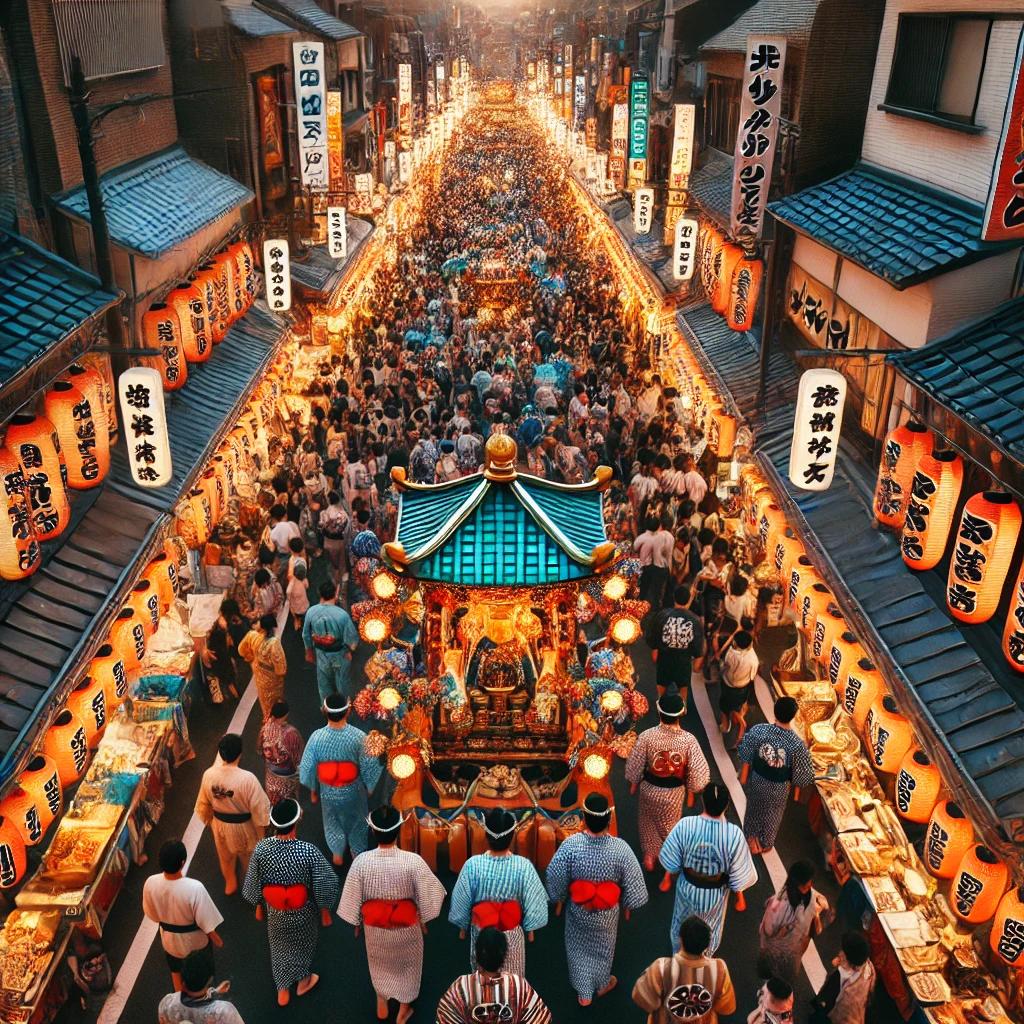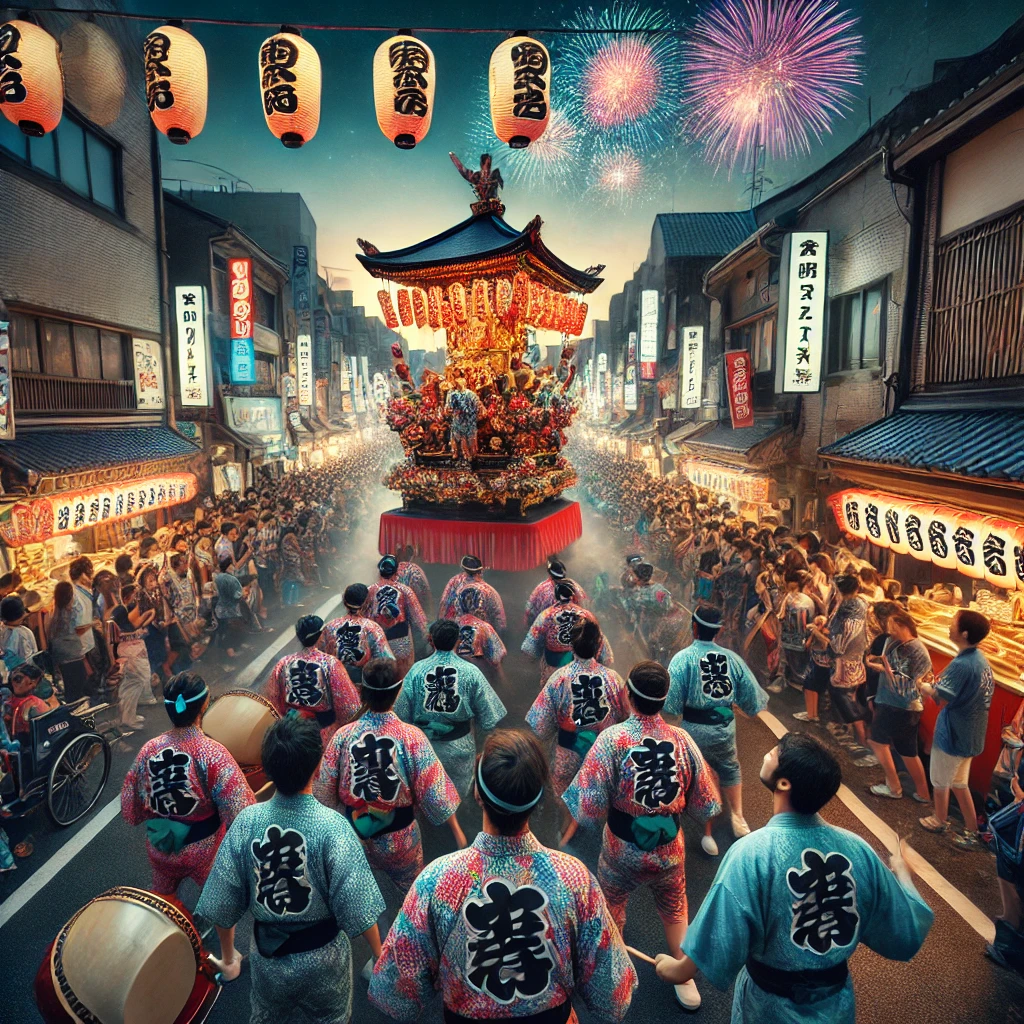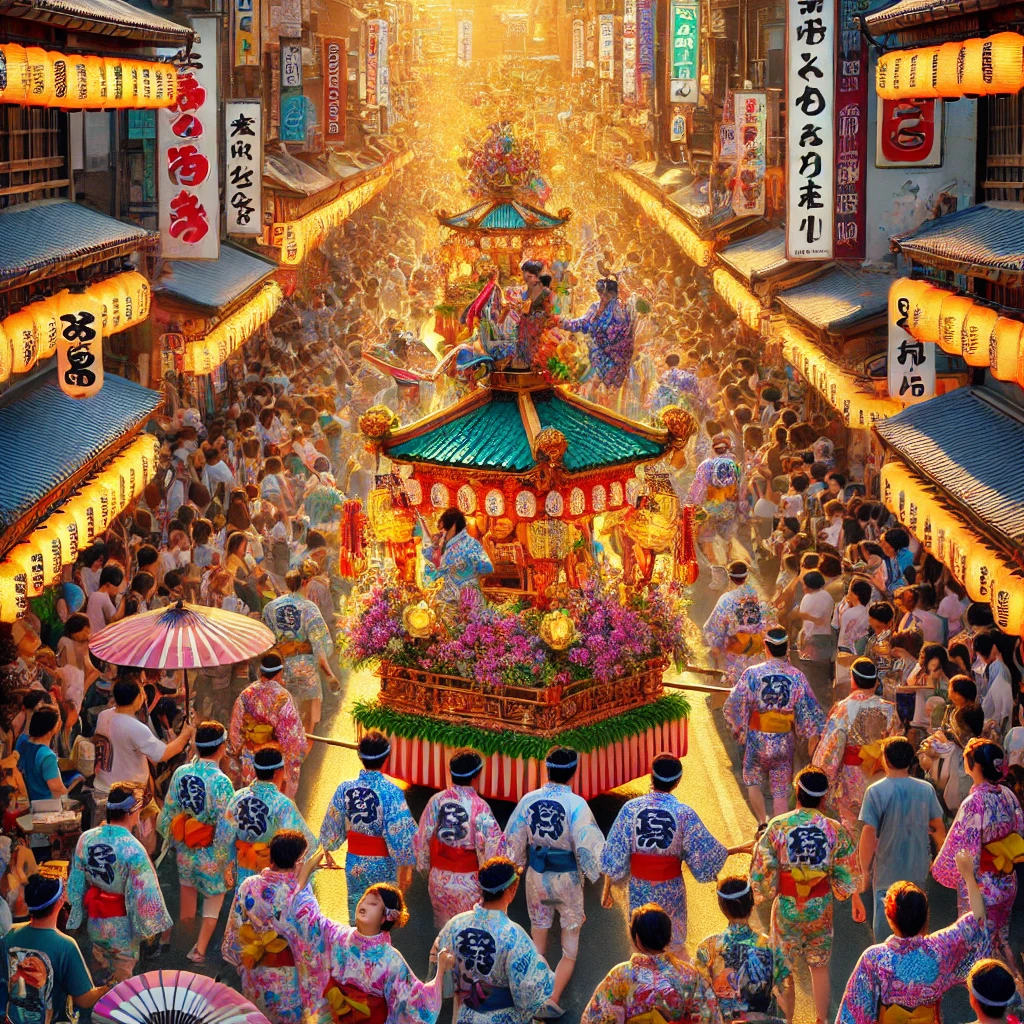Table of Contents
Introduction to Matsuri: The Heartbeat of Japanese Culture
Matsuri, or Japanese festivals, represent the vibrant and dynamic essence of Japan’s cultural heritage. These celebrations are steeped in history, tracing back to ancient agricultural rituals where communities honored deities, celebrated harvests, and sought blessings for prosperity. Over time, matsuri have evolved into multicolored events that engage communities and reflect regional uniqueness. Each festival is characterized by distinctive rituals, traditional music, and elaborate costumes that unify participants and emphasize local customs.
The significance of matsuri transcends mere celebration; these festivals serve as a vital thread in the fabric of Japanese society, reinforcing social bonds and collective identity. Many matsuri are deeply intertwined with Shinto beliefs, where they provide opportunities to connect with spiritual practices. For instance, processions featuring portable shrines, known as mikoshi, symbolize the divine presence amidst the people, fostering a sense of communal cooperation and spiritual awakening. In this regard, matsuri are not just events, but holistic experiences that facilitate a reaffirmation of cultural values.

Types of Matsuri: A Kaleidoscope of Celebrations
Matsuri, the traditional festivals of Japan, embody the rich cultural tapestry of the nation’s diverse regions and communities. These celebrations are not merely events; they are vibrant expressions of seasonal changes, religious beliefs, and communal bonds, each offering a unique experience. Understanding the various categories of Matsuri can enhance one’s appreciation of these festivities. Three primary types of Matsuri include seasonal festivals, religious festivals, and community gatherings.
Seasonal festivals mark the transition of the seasons, celebrating nature’s cycles through vibrant parades, rituals, and feasting. Events like Hanami, which welcomes spring as people gather to view cherry blossoms, and Tanabata, where wishes are expressed through colorful streamers, are exemplary of this type. The festivals often highlight local specialties, providing an excellent opportunity for attendees to savor regional foods and engage with the local culture.
Religious festivals, on the other hand, intertwine spiritual significance with community involvement. These Matsuri often feature elaborate processions, purification rituals, and offerings to deities. One of the most recognized religious celebrations is Gion Matsuri in Kyoto, which dates back to the 9th century. Such festivals serve to reaffirm community values, honor ancestral spirits, and foster a sense of unity among participants.
Community gatherings represent another vital aspect of Matsuri. These events emphasize local pride and social cohesion, often revolving around specific local traditions or themes. Celebrated throughout boroughs, such festivals can include contests, sports, and performances that reflect the unique identity of the community. Examples include the Awa Odori dance festival, where locals and visitors alike partake in lively dances that foster camaraderie.
In exploring these various types of Matsuri, individuals can identify what resonates with their interests and cultural curiosities, making their experience in Japan even more enriching and engaging.
Iconic Matsuri Across Japan: Festivals You Can’t Miss
Japan is home to countless Matsuri that reflect its rich cultural heritage and communal spirit. Among these, the Gion Matsuri in Kyoto stands out as one of the most iconic. Held every July, this month-long celebration culminates in a grand parade featuring beautifully decorated floats known as “yamaboko.” The festival, which dates back to the 9th century, includes various events, such as traditional music performances and the striking procession of floats through the streets of Kyoto. Visitors during this time can immerse themselves in the local culture and enjoy the stunning sights that the festival offers.
Another significant festival is the Nebuta Matsuri in Aomori, which takes place in early August. This vibrant festival showcases enormous illuminated paper lanterns known as “nebuta,” which depict historical or mythical figures. The atmosphere is lively, with participants dressed in colorful traditional attire performing energetic dance routines as they parade through the streets. The festival lasts for several days and culminates in a spectacular finale featuring a large fireworks display, making it a must-visit for anyone hoping to experience Japan’s festive spirit up close.
In Tokyo, the Sanja Matsuri, celebrated in mid-May, honors the three founders of Asakusa’s Senso-ji temple. This festival features over 100 portable shrines (mikoshi) carried by enthusiastic participants through the streets of Asakusa. The highlight is the energetic chanting and dancing that accompany the procession, creating an electric atmosphere that captivates both locals and tourists alike. Notably, the Sanja Matsuri emphasizes community bonds and showcases traditional Japanese craftsmanship through the intricate details of the mikoshi. Each of these iconic Matsuri embodies the essence of Japanese culture, making them essential experiences for every traveler.
Local Matsuri: Uncovering Hidden Gems
While many travelers flock to Japan’s famous festivals, such as Gion Matsuri in Kyoto or Nebuta Matsuri in Aomori, Japan is home to a myriad of local Matsuri that offer equally captivating cultural experiences. These lesser-known festivals, often celebrated in small towns and rural areas, provide an authentic glimpse into regional traditions and customs, allowing visitors to engage more intimately with the local community.
One such festival is the Hōnen Matsuri, celebrated every spring in the town of Inazawa, located in Aichi Prefecture. This unique event centers around fertility and abundance, highlighted by a vibrant procession featuring a phallic symbol made from rice and wrapped in colorful cloth. The festival showcases traditional rituals designed to ensure a bountiful harvest, a practice deeply rooted in the community’s agricultural heritage. Attending Hōnen Matsuri offers visitors the opportunity to witness the joyous atmosphere and partake in engaging local customs that have been preserved over generations.
Another hidden gem is the Yamakasa Matsuri in Fukuoka, a dynamic festival that combines competition and ritualistic charm. Occurring in July, this Matsuri features teams from different neighborhoods vying to carry elaborate floats through the streets to the sound of chants and drums. The event not only emphasizes athleticism and teamwork but also fosters a sense of community pride and cohesion. Unlike larger Matsuri, which may often feel overwhelming, Yamakasa encourages interaction among participants and onlookers, helping forge connections and build lasting memories.
Exploring local Matsuri allows visitors to not only witness lesser-known yet fascinating traditions but also supports local economies and cultural preservation. These regional festivals serve as a reminder of Japan’s rich tapestry of traditions that, while overshadowed by more prominent events, deserve recognition and celebration. Thus, venturing off the typical tourist path can reveal extraordinary experiences that enhance one’s understanding of Japan’s diverse cultural heritage.

The Role of Tradition in Matsuri: Preserving Cultural Heritage
Matsuri, Japan’s traditional festivals, serve as a vibrant expression of cultural heritage, deeply rooted in the country’s history and communal life. These celebrations are characterized by unique customs, practices, and attire that have been passed down through generations, embodying the values and identity of local communities. In the face of modernization and globalization, the preservation of these traditions becomes increasingly important, as they provide a sense of belonging and continuity in a rapidly changing world.
Community involvement is crucial for keeping these traditions alive. Local groups organize various activities to ensure that younger generations are introduced to their cultural heritage. For instance, workshops dedicated to traditional crafts, such as kimono-making or drum-playing, educate the youth on the skills required for festival participation. This hands-on experience not only fosters a deep appreciation of their heritage but also strengthens community bonds. Over time, as youths participate in these matsuri, they develop a sense of pride and responsibility to continue the traditions that define their communal identity.
Moreover, the challenges posed by modernization can often manifest as a shift in values that may overlook the significance of traditional practices. Despite these pressures, many communities actively engage in efforts to revitalize interest in their heritage. Festivals are adapted to incorporate contemporary elements, making them more appealing to both locals and tourists alike, without sacrificing their essence. This delicate balance enables the celebration of matsuri to flourish amid changing societal norms.
Ultimately, the role of tradition in matsuri cannot be overstated. These festivals not only serve as a bridge to the past but also as a means of navigating the present and future. Efforts to preserve cultural heritage through annual celebrations are essential in fostering community engagement and ensuring that the richness of Japan’s diverse traditions remains alive for generations to come.
Experiencing Matsuri: Tips for Festival-Goers
Attending a Matsuri, or Japanese festival, is a thoroughly enriching experience that allows visitors to immerse themselves in the vibrant culture and traditions of Japan. To make the most of this unique opportunity, it is essential to be prepared and aware of certain cultural norms and expectations. Here are some tips to enhance your festival experience.
First and foremost, consider your attire. Wearing traditional clothing such as a yukata (a casual summer kimono) greatly respects the festival atmosphere while enabling you to engage in the experience fully. While it is not mandatory to wear traditional clothes, doing so helps you blend in and reflects your appreciation for the culture. If a yukata is not readily available, opt for comfortable and modest attire, keeping the warm weather in mind, particularly during summer festivities.
Participation is a key aspect of Matsuri. Attendees are encouraged to join in various activities, such as dances, games, or parades, showcasing their appreciation for local customs. If you are uncertain about how to engage, observe the locals first. Understanding how the community interacts during the festival can provide helpful insights into acceptable behaviors and participation styles.
Etiquette plays a vital role in ensuring a positive experience for both yourself and the festival organizers. Be respectful when taking photographs; always ask permission before photographing individuals, particularly participants in traditional attire. Additionally, maintaining cleanliness is crucial—dispose of trash properly and be mindful of your surroundings. Respect the culture by standing quietly during ceremonies, as this demonstrates reverence for their traditions. It is also advisable to familiarize yourself with basic Japanese phrases, which can enhance your interaction with local attendees.
By following these tips, festival-goers can engage respectfully and enjoyably in Matsuri celebrations, allowing for a deeper connection with the diverse cultural heritage of Japan.
Food at Matsuri: A Culinary Journey
At the heart of Japan’s vibrant Matsuri celebrations lies a culinary landscape that captivates the senses. Each festival showcases unique foods and snacks, many of which are deeply rooted in regional traditions and local ingredients. From savory delights to sweet treats, the festival atmosphere is inextricably linked to the experience of enjoying street food, which becomes a highlight for both locals and tourists alike.
One of the most iconic festival foods is yakitori, skewered grilled chicken often seasoned with salt or a savory tare sauce. Stalls serving yakitori can be found at almost every Matsuri, enticing visitors with the tantalizing aromas that fill the air. Another popular dish is takoyaki, a ball-shaped snack filled with diced octopus, green onions, and tempura scraps. Cooked in specially designed molds, these golden, crispy bites are typically drizzled with sauce and topped with bonito flakes, offering an explosion of flavor in every mouthful.
Additionally, festival-goers can indulge in sweet treats such as daifuku, a rice cake filled with various ingredients ranging from sweet red bean paste to seasonal fruits. The delight of tasting daifuku enhances the joyous atmosphere of the Matsuri while reflecting the region’s culinary heritage. Regional specialties contribute to the festival diversity, with each locality offering dishes that encapsulate its unique culture.
The experience of relishing street food during these celebrations is not merely about the flavors; it also encompasses the lively interactions with vendors and fellow attendees, creating a sense of community. As people gather around food stalls, sharing laughter and stories, the culinary adventure at Matsuri enriches the overall festival experience. Whether it’s tasting a bowl of ramen or indulging in mochi, food at Matsuri transforms a simple celebration into a culinary journey, making it an integral part of Japanese culture.
Matsuri and Technology: The Modern Evolution of Festivals
Matsuri, the traditional Japanese festival, is renowned for its vibrant celebrations that showcase a rich tapestry of culture, history, and community spirit. In recent years, technology has increasingly influenced these age-old festivals, marking a significant evolution in how they are organized, promoted, and experienced. The integration of modern tools serves to enhance the Matsuri experience while retaining its cultural essence.
One notable impact of technology on Matsuri is the rise of social media platforms. Organizers are now utilizing sites such as Instagram, Twitter, and Facebook to reach broader audiences beyond traditional geographical boundaries. These platforms allow festival-related images, videos, and updates to be shared instantly, increasing visibility and drawing in both locals and tourists. Festivals are now able to tap into the digital community, fostering engagement and excitement long before the events take place.
Live streaming technology has also transformed how Matsuri are experienced, enabling individuals who cannot attend in person to participate virtually. This innovation not only provides a glimpse into the festivities but also allows for real-time interactivity, where viewers can comment and engage with organizers and performers. By offering a digital presence, festivals can attract a global audience, further bridging the gap between tradition and modernity.
Moreover, advancements in logistics and event management software streamline the preparation process, making it easier to coordinate the various elements that contribute to the success of a Matsuri. From digital ticketing systems to apps that provide festival schedules and maps, technology aids in organizing crowds effectively while enhancing visitor experience. These tools ensure that the essence of Matsuri is preserved even as they adapt to contemporary advancements, maintaining their significance in Japanese culture.
Conclusion
Festivals, or Matsuri, play a pivotal role in the cultural fabric of Japan, serving as a vibrant expression of community spirit and heritage. Each Matsuri, often deeply rooted in local traditions and history, showcases the unique customs that have been preserved over generations. Through elaborate parades, traditional performances, and communal participation, these celebrations foster a strong sense of belonging among residents and visitors alike. They offer insight into the local identity, allowing participants to connect with the stories and values that define a community.
The social significance of Matsuri extends beyond festivity; it promotes inclusivity, encourages collaboration among various community members, and supports local economies. As festival-goers engage with one another, they form lasting relationships and strengthen neighborhood ties. Such interactions ultimately contribute to a more cohesive society, demonstrating the unifying power of shared experiences and traditions. Furthermore, Matsuri often reflects a deep connection to nature and spirituality, reinforcing the importance of celebrating the changing seasons and honoring ancestral beliefs.

For those unfamiliar with these enchanting celebrations, attending a Matsuri can be a transformative experience, providing a unique opportunity to immerse oneself in Japan’s cultural heritage. From the lively sounds of taiko drums to the intricate designs of traditional clothing, each aspect of Matsuri invites participants to embrace the depth of cultural significance these events hold. By learning, participating, or even just observing, one can appreciate the impact of these communal celebrations on local and national identity.
The ongoing relevance of Matsuri in contemporary Japan highlights their importance in safeguarding team spirit and cultural values for future generations. By engaging with these vibrant festivals, individuals contribute to the preservation and rejuvenation of cultural practices that define Japanese identity, allowing them to thrive in an increasingly globalized world.





